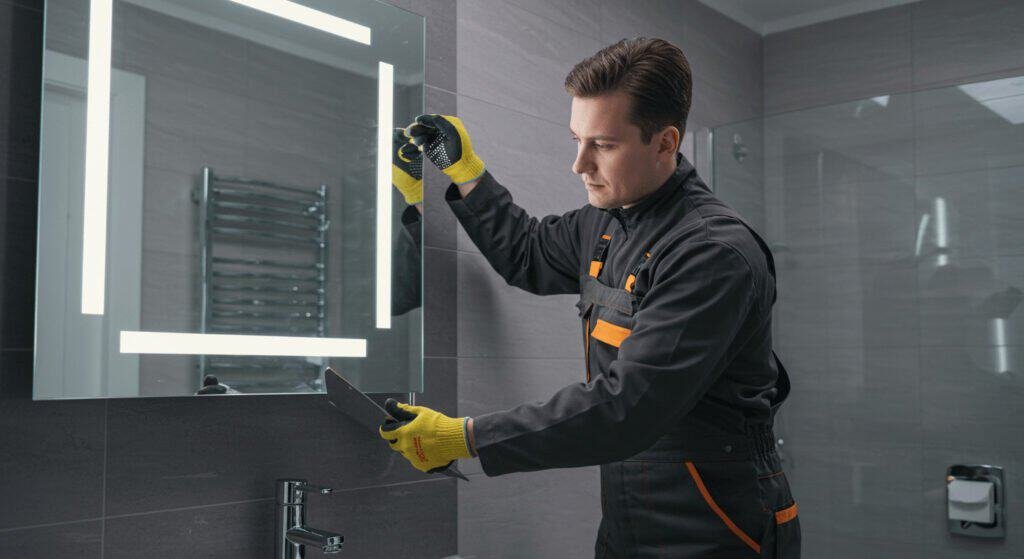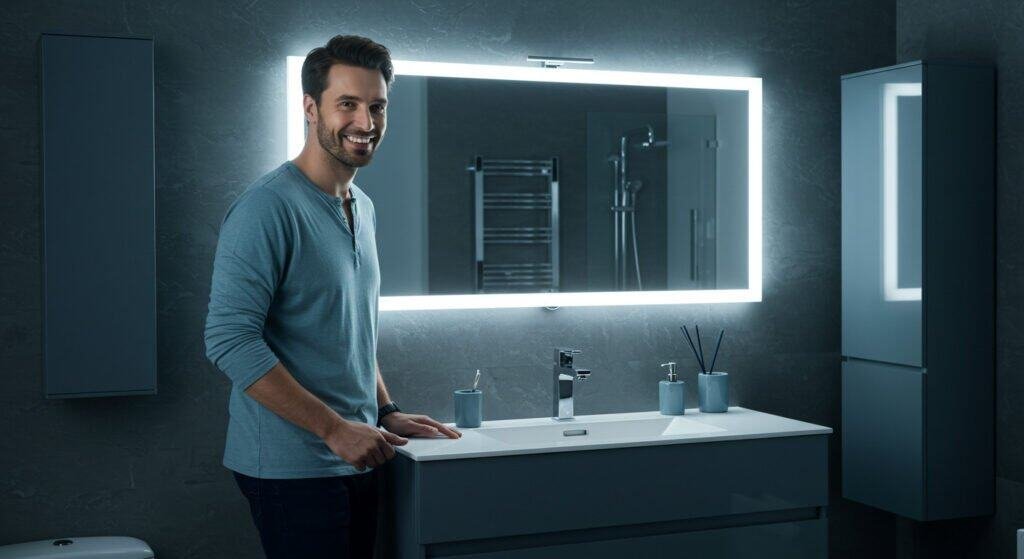How do led mirrors work? Traditional bathroom mirrors leave you struggling with poor lighting and shadows during grooming routines. LED mirrors revolutionize your daily experience by integrating advanced lighting technology directly into the mirror surface, providing optimal illumination for every task.
LED mirrors work by incorporating Light Emitting Diodes (LEDs) into the mirror frame or behind the glass surface. These energy-efficient lights receive power through a low-voltage electrical system, typically 12V or 24V DC, which is converted from standard household current through an integrated transformer. The LEDs distribute even illumination across the mirror surface, eliminating shadows and providing superior lighting quality.
Understanding the technical mechanisms behind LED mirror functionality helps you make informed purchasing decisions and optimize installation requirements.
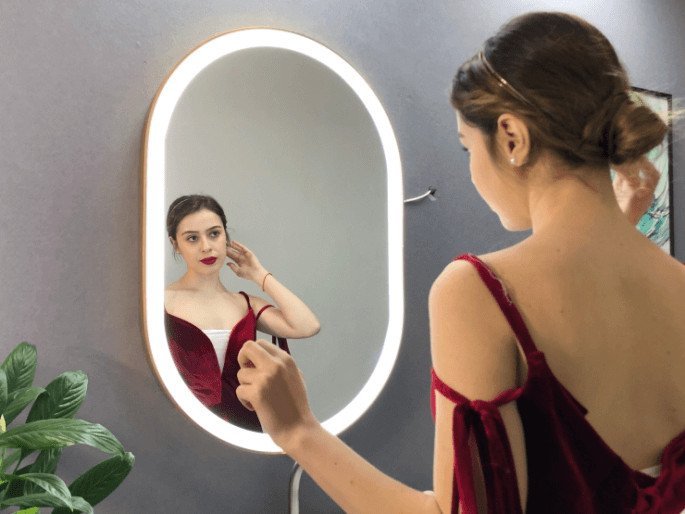
How Do LED Mirrors Work with Lights
LED mirrors use advanced lighting systems that are different from traditional lighting solutions. The technology relies on semiconductor materials that emit light when an electrical current passes through them. This results in consistent and controllable illumination.
Technical Implementation: LED mirrors utilize strategically positioned LED strips or individual diodes around the mirror perimeter or behind frosted glass sections. These LEDs operate on direct current and produce minimal heat compared to incandescent or fluorescent alternatives. The light distribution system ensures uniform coverage across the entire mirror surface, eliminating the harsh shadows typically created by overhead bathroom lighting.
The integration process involves embedding LED components during manufacturing, creating a seamless connection between the mirror and lighting elements. Additionally, diffusion materials are used to soften the light output, creating natural looking light that closely replicates daylight conditions. Also, the ability to have precise control over the color temperature of the light is possible. You can go from warm white (3000K) to cool white (6500K) to suit your needs.
How Do LED Bathroom Mirrors Work
LED Mirrors involve specially designed features for high humidity environments. We use waterproof LED systems rated at IP44 or higher. Our LED bathroom mirrors are safe and protected to use in high humidity bathroom conditions.
Moisture Management Systems: The primary technical challenge involves protecting electrical components from bathroom humidity. Manufacturers achieve this through sealed LED housings, moisture-resistant wiring, and specialized gaskets that prevent water ingress. Advanced bathroom LED mirrors include integrated defogging systems that use low-voltage heating elements behind the mirror surface to prevent condensation buildup.
LED mirrors for bathrooms sometimes include motion sensors which will turn the light on when someone enters the room. These sensors employ infrared technology to detect body heat and motion, enabling a hands-free operation for convenience and energy efficiency.
Additionally, many models include dimming capabilities that adjust brightness based on ambient light conditions, creating optimal lighting throughout different times of day. The combination of waterproof construction, automated controls, and specialized heating elements makes LED bathroom mirrors significantly more complex than standard lighted vanity mirrors.
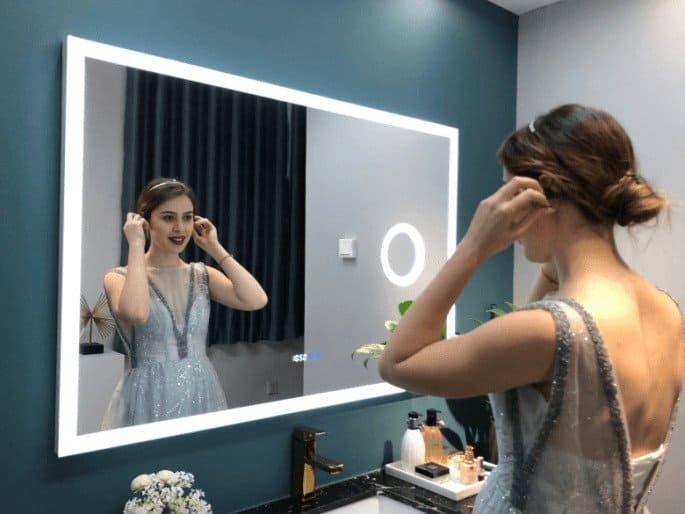
How Are LED Mirrors Powered
LED mirrors utilize advanced power management systems. They take regular household AC voltage and convert it into low-voltage DC power that the LEDs require. This conversion process is multi-staged, ensuring the safety, efficiency, and long life of the LED lighting system.
Power Conversion Process: The electrical system begins with a step-down transformer that reduces standard 120V or 240V household current to safe low-voltage levels, typically 12V or 24V DC. This transformation occurs through an integrated driver circuit that also regulates current flow to prevent LED degradation. The driver maintains consistent voltage output despite fluctuations in household power supply, ensuring stable light output and extended LED lifespan.
| Power Source Type | Voltage Output | Installation Method | Typical Applications |
|---|---|---|---|
| Hardwired System | 12V/24V DC | Direct electrical connection | Permanent bathroom installations |
| Plug-in Adapter | 12V DC | Standard wall outlet | Vanity mirrors, temporary setups |
| Battery System | 3.7V-12V DC | Internal rechargeable batteries | Portable mirrors, areas without electrical access |
Modern LED mirrors include surge protection, overcurrent protection, and thermal protection. These safety systems constantly monitor the electrical conditions and if they become dangerous, they shut the mirror off to protect itself. They are extremely energy efficient using between 10-30 watts, allowing you to light your space with a fraction of the electricity an incandescent light would require.
How Do You Power an LED Mirror
Installing power for LED mirrors involves understanding the electrical requirements in your area, as well as local building codes. A certified electrician will make sure that your wiring is correct and up to code, especially if you are hard-wiring your LED mirror directly into your home’s electrical system.
Installation Methods: Hardwired LED mirrors connect directly to household electrical systems through dedicated circuits, typically requiring 15-amp breakers for standard residential installations. This method provides the most reliable power source and eliminates visible cords or adapters. The installation process involves running appropriate gauge wiring from the electrical panel to the mirror location, incorporating GFCI protection as required by electrical codes in bathroom applications.
Alternatively, plug-in LED mirrors offer flexibility for locations where hardwiring is impractical. These systems include external adapters that convert household current to appropriate low-voltage DC power. The adapter specifications must match the mirror’s power requirements precisely to prevent damage or performance issues.
Professional electricians typically suggest dedicated outlets, and not just a plug strip, for LED mirrors. This can help prevent overloading a circuit and ensures a consistent supply of power to your mirror. Also, the brackets for wall-mounted LED mirrors often have wire management systems built-in allowing you to hide the wires while maintaining easy access to them for maintenance or repairs.
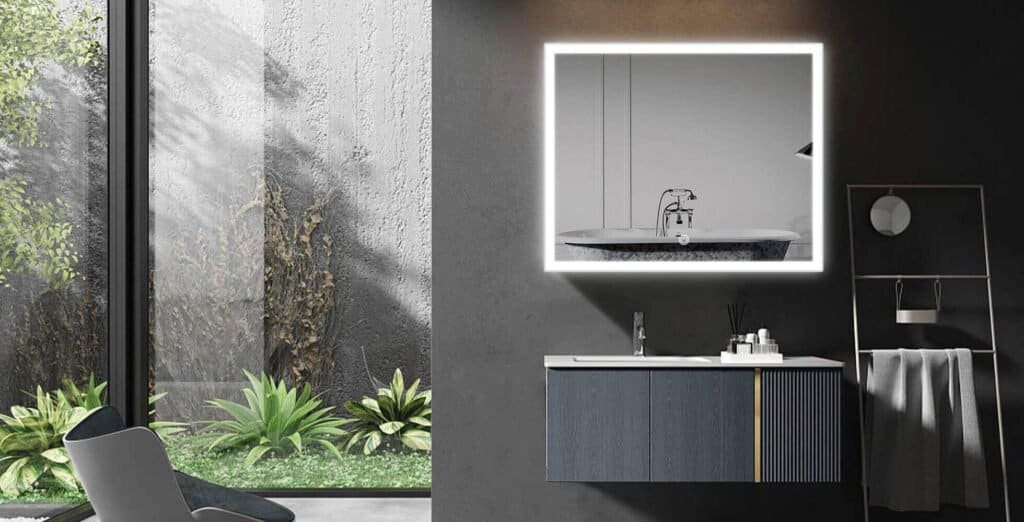
Do LED Vanity Mirrors Need to Be Plugged In
The single most important consideration for LED vanity mirrors is power. You need to know where your power source is going to be and how you are going to get power to the mirror because that will help you to make the best selection for your particular installation location and use case.
Power Source Options: Traditional LED vanity mirrors require electrical connections through either hardwired systems or plug-in adapters. However, innovative battery powered LED mirror designs provide installation flexibility for locations without convenient electrical access. Battery powered LED bathroom mirror models incorporate rechargeable lithium-ion batteries that provide 4-8 hours of continuous operation depending on brightness settings and feature usage.
Full-length LED mirrors are the latest development in portable mirror technology. These mirrors use large-capacity battery systems along with very efficient LED arrays to allow the mirror to operate without being plugged into the wall.
The battery systems typically feature USB charging capabilities, allowing convenient recharging through standard power adapters or computer connections. Battery-powered LED mirrors are great for areas where you don’t have a power connection, like a rental space, temporary installation, or if running new electrical is too expensive or a hassle. But with battery-powered options, you have to think about keeping them charged. Depending on the particular model, you may sacrifice features versus something that’s permanently wired and installed.
How Do Lighted Mirrors Work
Beyond LED technology, lighted mirrors can employ various lighting solutions available on the market. By understanding these different technologies, you will be able to choose the best option for your situation.
Technology Comparison: Traditional lighted makeup mirror designs often incorporate fluorescent tubes that provide broad-spectrum illumination suitable for detailed grooming tasks. These systems operate through electromagnetic ballasts that regulate current flow and prevent flickering. However, fluorescent systems generate more heat and consume significantly more energy than modern LED alternatives while offering less precise color temperature control.
Incandescent lit vanity mirrors use regular old tungsten filament bulbs that are positioned around the edge of the mirror. These types of mirrors provide a very warm, natural looking light that some people really like. Unfortunately, they use a lot of power and generate a fair amount of heat, which can be an issue in a bathroom setting.
Halogen variants offer improved efficiency and longer lifespan compared to standard incandescent systems while maintaining similar light quality characteristics. Modern lighted bathroom mirror designs increasingly favor LED technology due to superior energy efficiency, extended lifespan, and enhanced control capabilities including dimming and color temperature adjustment features.
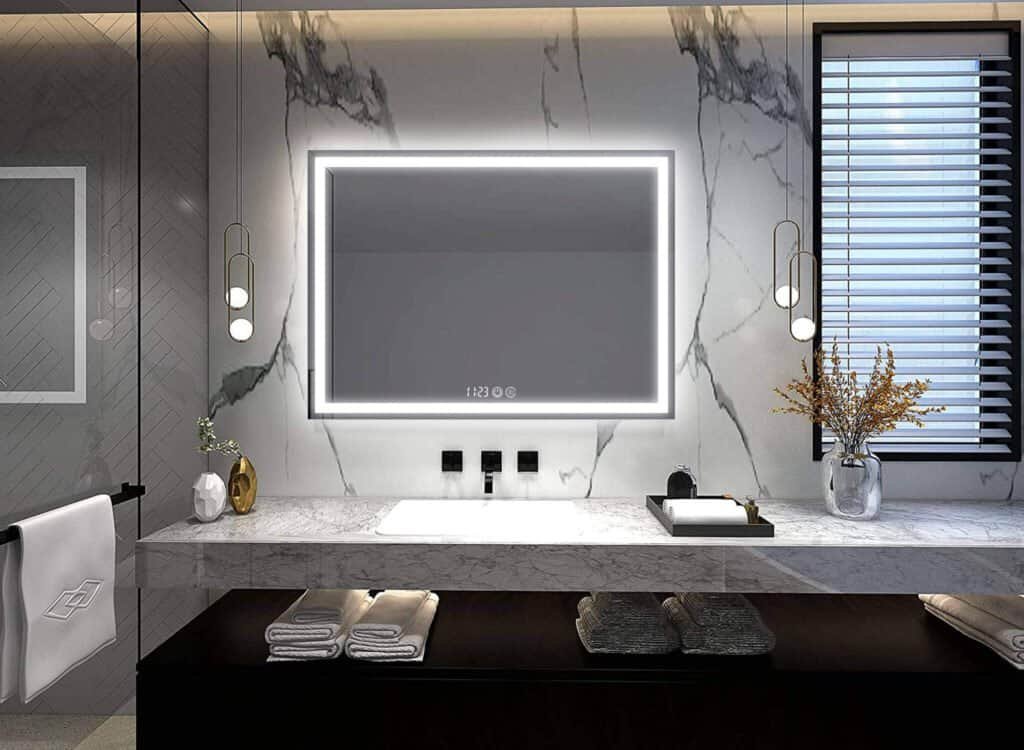
Pros and Cons of Lighted Mirrors
When judging lighted mirrors, you must consider their technical specs and how they will fit into your project or day-to-day life. This broader perspective will help you make a more informed decision and get exactly what you need for your situation.
Technical Advantages: LED bathroom mirrors provide superior energy efficiency compared to traditional lighting solutions, typically consuming 70-80% less electricity while providing equivalent or better illumination quality. The extended lifespan of LED components, often exceeding 50,000 hours, significantly reduces maintenance requirements and replacement costs over the mirror’s operational lifetime. Modern lighted mirrors for bathrooms offer precise color temperature control, enabling users to optimize lighting conditions for different activities such as applying makeup, shaving, or general grooming tasks.
| Advantages | Disadvantages |
|---|---|
| Energy efficiency (70-80% less consumption) | Higher initial purchase cost |
| Long lifespan (50,000+ hours) | Complex installation requirements |
| Precise color temperature control | Potential electrical maintenance needs |
| Even light distribution eliminates shadows | Limited repair options for integrated systems |
| Smart features (dimming, sensors, Bluetooth) | Dependency on electrical power availability |
Implementation Challenges: The primary disadvantages include higher initial investment costs compared to traditional glass mirror alternatives and complex installation requirements that often necessitate professional electrical work. Integrated LED systems present repair challenges since individual component replacement may be impossible, potentially requiring complete mirror replacement if lighting systems fail. Additionally, some users experience adjustment periods when transitioning from traditional lighting to LED systems due to differences in light quality and color rendering characteristics.
Are LED Mirrors Worth It
To decide if LED mirrors are worth it, you need to look at the long-term value such as savings on your electric bill, how much more functionality you’ll get out of it, and how much happier you’ll be with the mirror. It’s this combination of both the quantitative and the qualitative perspective.
Cost-Benefit Analysis: LED vanity mirror systems typically recover their higher initial costs through energy savings within 2-4 years depending on usage patterns and local electricity rates. The superior energy efficiency of modern LED systems, combined with extended component lifespans, creates substantial long-term savings compared to traditional lighting solutions. Additionally, LED bathroom vanity mirrors eliminate the need for separate vanity lights, reducing both installation complexity and ongoing maintenance requirements.
In addition to the light, modern bathroom vanity mirrors have other functionality built into them. Many have Bluetooth speakers integrated, digital displays that show the time, temperature, weather forecast, or other information and some have smart home integration to complete the package for the tech-savvy consumer.
Backlit mirrors add to the ambiance in a bathroom offering both form and function. Depending on the configuration, they can fit any bathroom regardless of layout or design. For those concerned with electricity and energy efficiency, LED is the way to go. Even from a cost perspective, LED still makes sense considering the amount of electricity you’ll save in the long run.

Conclusion
LED mirrors combine advanced lighting technology with functionality. It works through more advanced electrical systems to give you better light but use less energy and be more convenient when using them in modern bathroom or vanity applications.
- Clik here to know What Is Copper Free Mirror?
- If you donot know how too choose the right bathroom height click here.
- Know more about LED bathroom mirror Problems
- Clik here to know why Touch Sensor Mirror Not Working
- Clik here to know What Are Standard Vanity Mirror Sizes?
- Clik here to know Why Are Mirrors So Expensive?
- Clik here to know Do LED Mirrors Need Electricity?
- Clik here to know Is a Lighted Mirror Enough Light for a Bathroom?
- Find out 10 Common LED Bathroom Mirror Problems Click Here

